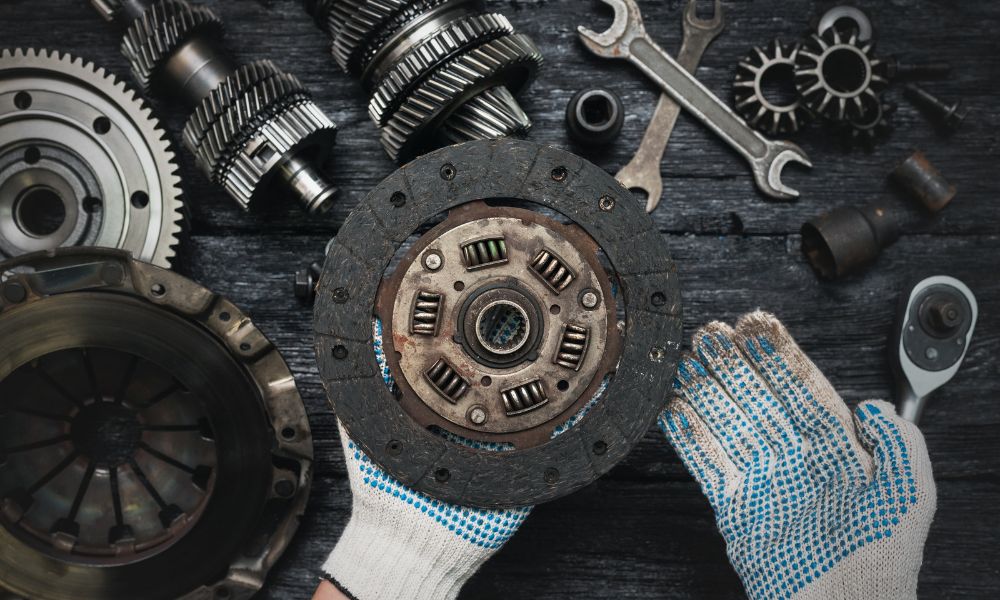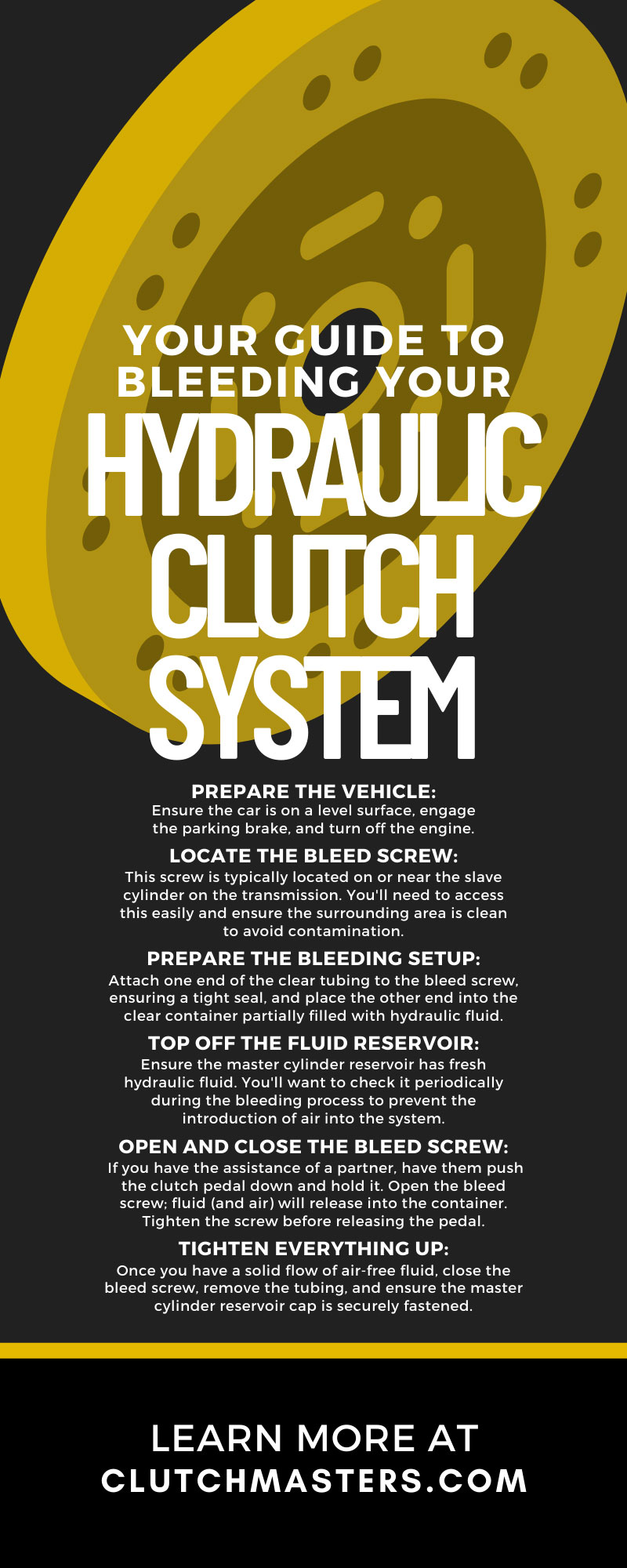Your Guide to Bleeding Your Hydraulic Clutch System

Your car's clutch serves as an integral connection point between the driver and the car. If the clutch feels spongy or struggles to shift gears, the issue could be due to air in the system. One of the most important maintenance procedures for cars with hydraulic clutches is releasing this air, also known as bleeding the clutch system.
While maintenance service centers can bleed the hydraulic clutch for you, it's also something you can do at home yourself. Below, our guide will show you how to bleed your hydraulic clutch system and explain some common pitfalls to avoid.
Basics of the Hydraulic Clutch System
To appreciate the art of clutch bleeding, one must first comprehend the system it serves. Unlike traditional cable-operated clutches, hydraulic clutches utilize fluid pressure to engage and disengage the gearbox from the engine, providing a more responsive and lighter pedal feel.
How It Works
The operation is seamlessly executed as the clutch pedal activates the master cylinder, which transmits hydraulic pressure through a line to the slave cylinder near the transmission. This pressure engages or disengages the clutch, allowing for gear changes without physically disconnecting the engine from the transmission through the typical “clutch your teeth” effort of a cable-based system.
Benefits Over Mechanical Systems
Hydraulic systems boast precision, consistency, and minimal service requirements compared to older mechanical systems. If maintained correctly, they can provide a lifetime of reliable service.
Why Hydraulic Clutch Maintenance Is Crucial
Like an engine, a clutch needs regular upkeep to perform at its peak. The hydraulic clutch system is no exception. Over time, air can find its way into the system, leading to a spongy pedal feel and decreased clutch engagement.
What Happens When Air Is Intruding
The presence of air bubbles prevents the transmission of full fluid pressure, which is key to a clutch's actuation. This can lead to incomplete clutch disengagement, making gear changes difficult or causing premature clutch wear.
Nipping Issues in the Bud
Bleeding the hydraulic system ensures all air is removed, allowing for optimal circulation of the hydraulic fluid. Regular maintenance prevents unexpected clutch failures and maintains the precision that drivers expect, especially in high-performance vehicles.
Preparing for the Bleed
Before you roll up your sleeves and prepare to restore your clutch system, you'll need a few items in your automotive toolkit to perform the job efficiently.
Tools and Materials Required
You'll require a wrench or tubing spanner, a clear container, flexible transparent tubing length, and a supply of manufacturer-recommended hydraulic fluid. The clear container ensures any air or old fluid removed during the bleeding process is visible and doesn't return to the system.
Where To Source Your Supplies
Hydraulic clutch bleeding kits are available and can streamline the process. If you prefer the DIY approach or don't have a local automotive store nearby, you can source these items online from reputable automotive parts suppliers.
Step-by-Step Guide to Bleeding Your Hydraulic System
- Prepare the vehicle: Ensure the car is on a level surface, engage the parking brake, and turn off the engine.
- Locate the bleed screw: This screw is typically located on or near the slave cylinder on the transmission. You'll need to access this easily and ensure the surrounding area is clean to avoid contamination.
- Prepare the bleeding setup: Attach one end of the clear tubing to the bleed screw, ensuring a tight seal, and place the other end into the clear container partially filled with hydraulic fluid.
- Top off the fluid reservoir: Ensure the master cylinder reservoir has fresh hydraulic fluid. You'll want to check it periodically during the bleeding process to prevent the introduction of air into the system.
- Open and close the bleed screw: If you have the assistance of a partner, have them push the clutch pedal down and hold it. Open the bleed screw; fluid (and air) will release into the container. Tighten the screw before releasing the pedal.
- Repeat steps: Repeat the last step until you don’t see air bubbles in the tube leading from the bleed screw to the container. Ensure the fluid level in the master cylinder reservoir remains above the minimum line.
- Tighten everything up: Once you have a solid flow of air-free fluid, close the bleed screw, remove the tubing, and ensure the master cylinder reservoir cap is securely fastened.
Common Pitfalls
Mistakes can compound complications. Here's how to steer clear of common errors during the bleeding process.
Over-Tightening the Bleed Screw
The screw doesn't need an excessive amount of torque to seal. Overtightening can cause damage and make the next bleed more challenging.
Ignoring the Master Cylinder
Many beginners only bleed the system at the slave cylinder, forgetting that the air can also rise to the master cylinder. Bleeding at both ends ensures the expulsion of all air.
Recognizing the Need for Clutch Attention
Reviewing the telltale signs that your clutch needs a helping hand can save you from more significant issues.
Spongy or Unusual Pedal Feel
If the clutch pedal feels spongy or different from its usual self, it may indicate that air has infiltrated the hydraulic system.
Difficulty Shifting Gears
Struggling with gear changes, such as difficulty in smoothly moving from gear to gear or a grinding sensation, indicates a problem with clutch engagement.
An Unexpected Burning Odor
If you notice a burning smell, particularly when operating the clutch, the clutch may be slipping due to an engagement issue, which can be attributed to air in the hydraulic system.
Frequently Asked Questions About Bleeding Your Hydraulic System
Hearing the common queries of fellow car enthusiasts can provide invaluable insights into the nuances of the hydraulic system and the bleeding process.
Can I Use Any Hydraulic Fluid?
It's highly recommended that you use the hydraulic fluid recommended by your vehicle's manufacturer. This ensures proper lubrication, sealing, and performance in various conditions.
Is "Pedal Pumping" Better Than Using a Bleeder Kit?
Both methods can be effective. The pedal pumping approach may require more repetitions but is entirely doable. A bleeder kit provides a more controlled environment, especially for beginners.
How Often Should I Bleed My Hydraulic Clutch System?
While there's no set interval within which you should perform this task, bleeding your system every two to three years or whenever you're changing the clutch or performing transmission maintenance is a good practice.
Find Hydraulic Clutch Parts and Kits at Clutch Masters Industries
We hope our guide to bleeding your hydraulic system helps you maintain your hydraulic clutch effectively to get the peak performance every driver craves from their vehicle. If you ever need to replace your clutch or require hydraulic clutch parts, Clutch Masters Industries has you covered.
Our wide inventory offers the highest quality hydraulic clutch components to ensure our customers get only the best for their cars. Browse our selection of parts, kits, and more online, or contact our staff to speak with a clutch expert today!



